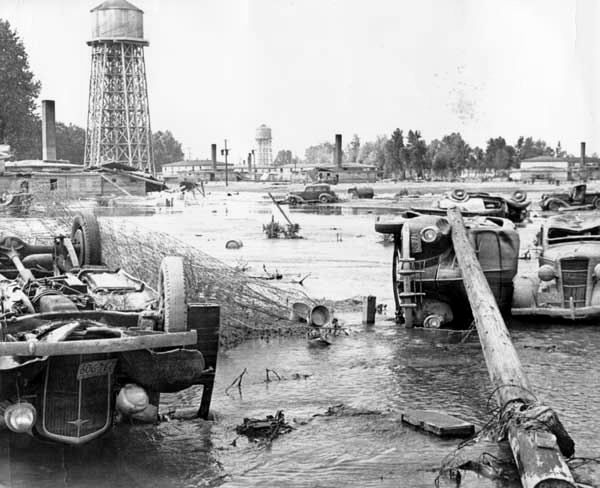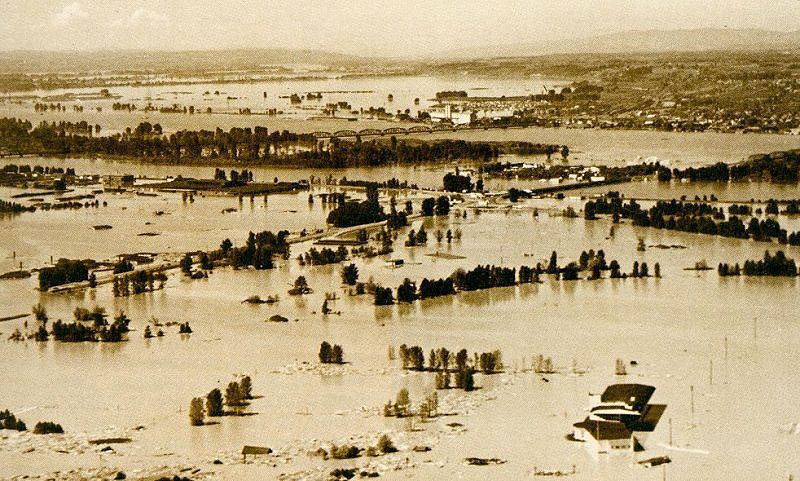
The Vanport Flood of 1948: A Chronicle of Destruction and Unsolved Mysteries
The Vanport Flood of 1948: A Chronicle of Nature’s Wrath and Lingering Shadows
In the annals of Oregon’s history, the Vanport Flood of 1948 stands as a stark reminder of the power of nature and the resilience of the human spirit. It is a story of a city born out of necessity, a city that would disappear almost as swiftly as it had risen, leaving behind a legacy of destruction, heartache, and mysteries that still echo through the years.
Vanport, nestled on the low-lying floodplains of the Columbia River, was a bustling city born during World War II. With the need for shipyard workers and their families growing, the city burgeoned, swelling to a population of over 40,000 residents. At its peak, Vanport was the second-largest city in Oregon, a beacon of opportunity and growth.
However, the winter of 1947-48 brought with it a portent of the devastation to come. An unusually high level of snowfall in the Cascade Mountains led to a swollen Columbia River in the spring as the snow began to melt. Fears regarding the hastily constructed dikes protecting Vanport heightened, and whispers of impending disaster permeated the city.
As rumors and unease swirled, the local authorities and the railroad company responsible for the embankments seemed to downplay the threat. Reports of the dikes’ potential failure were dismissed, and many residents were reassured that they were safe. This complacency, whether born of ignorance or willful negligence, would have grave consequences.
On May 30, 1948, the unthinkable happened: a section of the railroad embankment serving as a dike failed, and the merciless waters of the Columbia River surged forth. Within hours, the city of Vanport washed away, its remnants lost to the river, and the lives of its residents forever altered. The flood claimed at least 15 lives, displaced thousands, and left a lasting scar on the region.
In the aftermath of the disaster, investigations into the causes and contributing factors were launched. Some of these inquiries led to revelations about the possible negligence on the part of the authorities and the railroad company, who may have been aware of the dikes’ vulnerability but failed to take adequate action to protect the city and its residents. These findings added an aura of mystery and suspicion to an already tragic event.

Furthermore, the racial and socioeconomic dynamics of Vanport, a city with a diverse population and a significant number of African American and low-income residents, raised questions about the response to the disaster and the subsequent efforts to rebuild and recover. Were the concerns of certain communities ignored, and did this contribute to the severity of the tragedy?
As the years have passed, the ghosts of Vanport continue to haunt the shores of the Columbia River, whispering tales of destruction and the enigmatic mysteries that remain unresolved. The story of the Vanport Flood of 1948 is a testament to the power of nature, the indomitable human spirit, and the shadows that sometimes lurk just beyond the reach of history’s grasp.
Today, the site where Vanport once stood bears witness to the impermanence of human endeavor and the enduring power of the natural world. As the waters of the Columbia River flow past, they carry with them the memories of a city lost, and the unanswered questions that still drift upon the currents. Through our ongoing efforts to understand the complex and interwoven strands of this narrative, we strive to illuminate the darkest corners of our history, to ensure that the lessons of Vanport are never forgotten.
As researchers and historians continue to investigate the Vanport Flood, new insights may yet be uncovered. The city’s rapid construction, driven by the urgency of wartime demands, may have led to structural weaknesses in the buildings and infrastructure that ultimately contributed to the disaster. Moreover, the political and social climate of the time may have influenced the decisions made by those in power, with potentially devastating consequences for the most vulnerable residents of Vanport.
The legacy of the Vanport Flood serves as a reminder of the importance of preparing for and respecting the power of nature. As we face the challenges of a changing climate, the lessons learned from Vanport become all the more relevant. We must ensure that our cities and communities are built with foresight and resilience and that the voices of all residents, regardless of their background or status, are heard and valued.
In the end, the story of the Vanport Flood of 1948 stands as a testament to the human capacity for hope, endurance, and rebirth in the face of overwhelming loss. It is a story that speaks to the very core of our shared experience, to the strength that lies within each of us, and to the mysteries that continue to challenge and inspire us.
As we stand upon the shores of the Columbia River and gaze upon the waters that once swallowed Vanport, we are reminded not only of the tragedy that unfolded but also of the potential for healing and renewal. It is our duty, as caretakers of history and as citizens of the world, to seek the truth, to learn from the past, and to build a future that is more just, more compassionate, and more resilient than ever before.
As we pursue the truth about the Vanport Flood and other events that have shaped our world, we strive to create a better, more enlightened society—one that is not only informed by the past but also inspired to create a brighter and more hopeful future.
